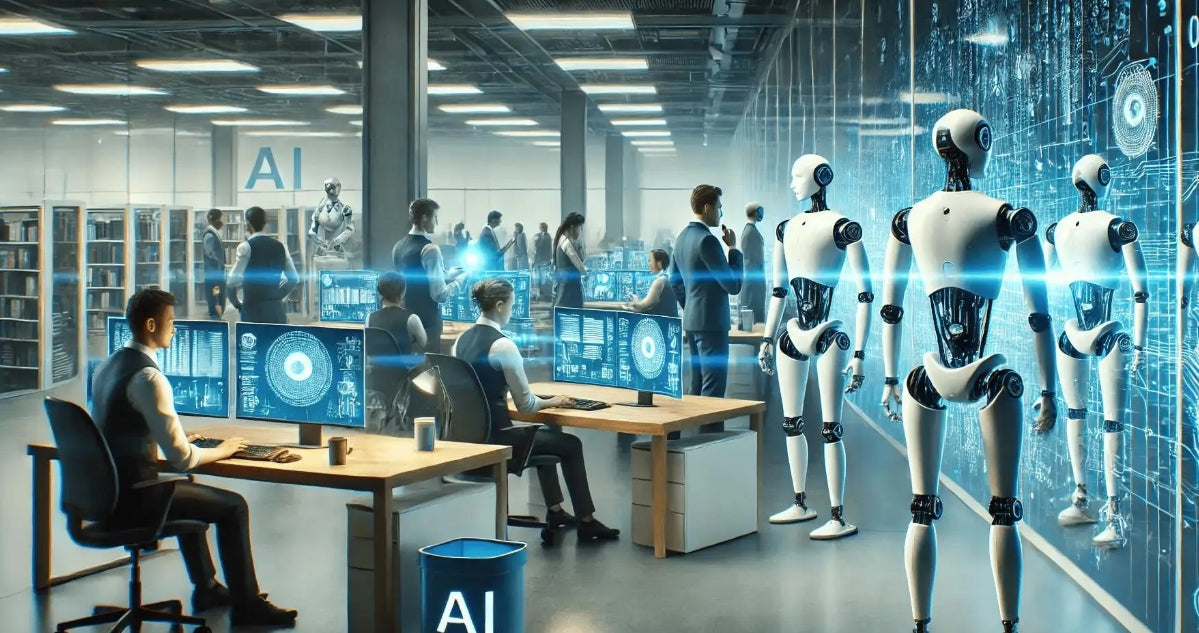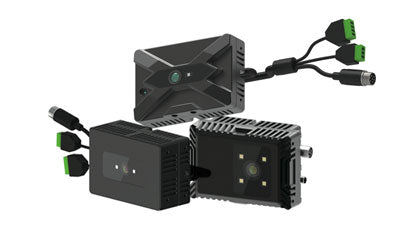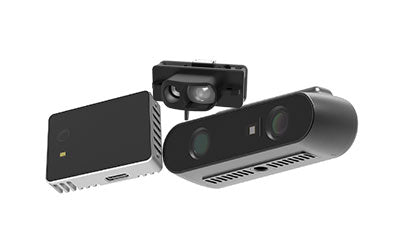TOF & New Human-Computer Interaction: Natural Gestures Empower Devices

With technological advancement, human-computer interaction is undergoing a profound transformation from traditional mouse and keyboard to more natural and intelligent gesture-based interaction. TOF (Time of Flight) 3D sensing technology plays a key role in enabling smart devices to achieve high-precision gesture recognition and skeletal tracking, pushing smart homes, automotive systems, smart TVs, and other fields into a new era of interaction.
What is a ToF time of flight camera?
A ToF (Time of Flight) camera is a device that acquires 3D depth information of objects by measuring the time taken for emitted light to reflect off objects and return to the sensor. It emits infrared light or laser pulses and calculates the flight time of the light to generate high-precision depth maps for 3D imaging and distance measurement.
From Mouse & Keyboard to Gesture Interaction
Traditional human-computer interaction relies mainly on mouse and keyboard. Although mature and easy to use, this interaction method has limitations. Users must input commands via physical keys, lacking intuitive natural interaction and with a higher learning curve for beginners. With rapid development of computer vision, semiconductor technology, and 3D imaging, gesture-based interaction has emerged as a new interaction paradigm.
Gesture interaction utilizes 3D TOF cameras and depth sensing technology to accurately capture user gestures, movements, and even skeletal postures, enabling contactless and touch-free operation. This breakthrough in 3D machine vision overcomes the limitations of traditional input devices, making smart devices more 'understanding' of users by allowing control through natural movements, greatly enhancing interaction convenience and immersion.
From initial simple gesture recognition to today’s multimodal human-computer interaction systems, gesture technology is widely applied in smart TVs, automotive systems, smart homes, and more, bringing smarter and more user-friendly experiences. In the future, with maturation of 3D SLAM and robotic 3D vision, gesture interaction will lead smart devices into a new interaction era.
TOF Enables High-Precision Gesture Recognition and Skeletal Tracking
Compared to traditional RGB cameras and infrared sensors, TOF 3D sensors emit light pulses and measure the return time difference to accurately calculate the distance between the object and the camera, generating high-resolution real-time depth images. This depth data greatly enriches environmental perception, no longer relying on flat images but acquiring spatial 3D structure.
3D TOF cameras capture complex spatial shapes and dynamic changes, excelling in hand motion recognition. Hands have complex bone structures, and 2D cameras struggle to accurately distinguish finger joint postures. TOF depth data provides 3D coordinates of fingers, enabling precise skeletal tracking. Using skeletal tracking algorithms, systems recognize finger bending, palm rotation, and wrist movement in real time, capturing subtle motion changes.
Based on high-precision skeletal tracking, smart systems support rich gesture recognition such as swipe, grab, pinch, tap, and rotate. By deeply understanding gestures, gesture interaction becomes more responsive and intuitive, significantly lowering the user’s learning curve and enhancing interaction fluidity and experience.
Additionally, TOF technology resists lighting interference and offers high-speed response, adapting to complex environments including strong light, low light, or dynamic backgrounds. Its low latency real-time processing supports AR/VR, smart homes, automotive interaction, and robotic control, driving natural interaction applications into broader fields.
With the integration of deep learning and AI, TOF-based gesture recognition systems continually improve accuracy and motion prediction, promising finer and smarter 3D gesture interaction, revolutionizing traditional human-computer communication.
Practical Applications in Smart TVs, Automotive Systems, and Smart Homes
As TOF 3D sensing technology matures, high-precision depth-based gesture interaction is widely applied in smart TVs, automotive infotainment, and smart homes, revolutionizing human-computer interaction.
In Smart TVs:
TOF sensors capture user gestures enabling touchless control. Users can switch channels, adjust volume, and navigate menus with simple hand waves or swipes, freeing them from traditional remotes. Thanks to TOF’s high-precision depth and skeletal tracking, gesture recognition is fast and accurate, enhancing viewing experience and convenience. Combined with voice recognition, multimodal interaction further enriches smart home entertainment ecosystems.
In Automotive Systems:
In automotive infotainment and smart cockpits, TOF sensors offer safe and convenient gesture control. Drivers can adjust climate, switch navigation, and control audio through gestures, reducing physical button use and minimizing distraction. TOF sensors also monitor occupant movements and postures, aiding fatigue detection and driver status monitoring, greatly improving driving safety. Automotive TOF interaction is a key direction for intelligent vehicle interfaces, enabling the smart cockpit vision.
In Smart Homes:
TOF technology combined with AI enables personalized smart control solutions. Users can naturally control lighting, curtains, security systems, etc., through gestures for true contactless operation. AI algorithms can adjust environmental settings based on user habits, creating personalized, comfortable living spaces. For example, lights automatically turn on when entering, curtains close smoothly, and security switches to standby mode, greatly improving convenience and security.
Through deep application of TOF in these scenarios, smart devices operate more intuitively, naturally, and efficiently, upgrading and popularizing intelligent ecosystems to meet modern users’ demands for smarter, more convenient lifestyles.
Accuracy and Latency Comparison: TOF’s Comprehensive Advantages Over Traditional Cameras and Infrared Sensors
Sensor choice is critical for building natural and efficient human-computer interaction systems. Traditional RGB cameras and infrared sensors played important roles in early applications but have obvious limitations in precision, real-time performance, and robustness. TOF 3D depth sensors, with excellent spatial perception, are gradually replacing these traditional solutions as core components in gesture interaction systems.
Limitations of RGB Cameras:
-
Dependence on Lighting: Highly sensitive to lighting conditions; performance drops under strong or weak light causing overexposure or noise.
-
Lack of Depth Information: Only capture 2D images, cannot determine actual distances between objects and camera, limiting complex gesture recognition and spatial awareness.
-
Affected by Occlusion: Image overlap or occlusion occurs in multi-user or complex backgrounds causing recognition failures.
Limitations of Infrared Sensors:
-
Low Resolution: Mostly used for coarse detection of body outline or movement, inadequate for detailed finger recognition or skeletal tracking.
-
Single Functionality: Suitable for simple proximity detection but lack spatial modeling ability and complex posture recognition.
-
Susceptible to Heat Interference: Performance degrades in high temperature or multiple IR source environments, increasing false triggers.
Technical Advantages of TOF 3D Sensors:
-
High-Precision Depth Data Acquisition
TOF cameras emit modulated light and accurately calculate the time of flight, rapidly obtaining the 3D coordinates of target objects. The generated depth maps have high resolution and accuracy, supporting hand skeletal recognition and detailed motion capture, meeting the demand for high-precision spatial data in AR/VR, smart terminals, human-computer interaction, and other application scenarios. -
Low-Latency Real-Time Response
TOF systems feature millisecond-level data acquisition and processing capabilities, significantly lower latency compared to traditional image recognition solutions, ensuring immediate response and smooth transitions during gesture recognition. Whether in dynamic game control or cockpit gesture control, low-latency interaction experience is crucial. -
All-Weather Environmental Adaptability
Unlike RGB solutions relying on visible light, TOF sensors operate in active infrared spectrum, unaffected by strong direct light or low illumination. Even in complete darkness or strong backlight conditions, they can stably output clear depth images, achieving true all-environment adaptability. -
Strong Occlusion Resistance and High Robustness
Leveraging high-frequency spatial point cloud scanning and algorithm optimization, TOF sensors effectively handle partial occlusions, dynamic blocking, and multi-user interference, maintaining stable and accurate gesture recognition. This is a key guarantee for building multi-scene adaptive natural interaction systems.
TOF Drives Continuous Expansion of the 3D Vision Market
With the above advantages, TOF 3D cameras have become critical components in Gesture-Based Interaction Technology, 3D Machine Vision Systems, and Spatial AI Platforms. Their wide deployment across consumer electronics, smart security, industrial inspection, automotive interaction, and other fields continuously expands the technical boundaries and commercial potential of the 3D machine vision market.
According to multiple industry research reports, the global TOF Depth Sensor Market is rapidly growing at a double-digit compound annual growth rate, becoming the sensing core for next-generation interactive intelligent devices.
Future Trends in Multimodal Human-Computer Interaction: Voice + Gesture + Context Awareness
With continuous advances in AI, 3D sensing, voice recognition, and perception fusion technologies, traditional single-modal human-computer interaction is gradually transforming into Multimodal Interaction Systems. Future interactions will be not only smarter but also more aligned with natural human communication, achieving a major leap from 'command-based' to 'understanding-based' interaction.
Multimodal Fusion: Creating Immersive Intelligent Experiences
In the next-generation interaction architecture, integrating TOF 3D Depth Sensing, voice recognition engines, and environmental understanding models enables devices to evolve from single-point responses to Multi-Dimensional Perception Systems. Specifically:
-
Speech Recognition
Through semantic parsing and contextual modeling, devices can understand natural language commands beyond preset instructions. Even in noisy environments, technologies like beamforming and sound source localization enable clear recognition and command interpretation. -
Gesture Recognition & Skeleton Tracking
Using TOF cameras to capture high-precision hand skeletal structures and dynamic trajectories, systems can recognize complex gestures such as swipe, click, pinch, and grab, enabling contactless control and mid-air operations, providing users with intuitive and free interaction modes. -
Context Awareness
Through sensor networks sensing illumination, temperature, object distribution, user behavior, and more in real-time, systems dynamically adjust interaction strategies. For example, devices can auto-wake when users approach, turn off screens when users leave, or detect false touches based on gestures, improving interaction safety and accuracy.
Application Upgrades: From Interaction to Intelligent Decision-Making Loops
Multimodal human-computer interaction extends beyond basic input/output to core intelligent system logic. Spatial perception algorithms like Visual SLAM (Simultaneous Localization and Mapping) are widely applied in smart robots, AR devices, and Automated Guided Vehicles (AGVs):
-
Smart Robots
By building 3D spatial maps via TOF cameras combined with visual SLAM, robots achieve indoor autonomous navigation. They can recognize user gestures to initiate tasks, then confirm execution via voice commands like “clean under the sofa” or “go to the kitchen for water,” completing complex workflows. -
Automated Guided Vehicles (AGVs)
In smart logistics or industrial environments, AGVs use multimodal perception for path planning, obstacle avoidance, and human-machine collaboration. For example, operators can wave a stop gesture, AGVs respond immediately, and after voice confirmation, continue moving, greatly enhancing efficiency and safety. -
Smart Homes and Intelligent Terminals
Devices like smart speakers, TVs, and lighting systems have entered multimodal fusion stages. Users can control music playback via voice, adjust volume by gesture, and the system automatically senses indoor brightness and occupancy to trigger scene linkage and intelligent recommendations. For instance, waving to turn on bedside lamps at night triggers a night mode with dimmed brightness to avoid glare.
Core Value of Multimodal Interaction: Understanding User Intentions
Compared to traditional 'input-execute' interaction chains, multimodal systems possess User Intention Modeling capabilities. By analyzing voice tone, gesture actions, and contextual environment, devices can deliver highly personalized and context-aware responses. For example, when a user waves while saying 'open this,' the system combines gesture direction and semantic context to precisely identify the target and execute the command, truly realizing Intent-Based Interaction.
Future Outlook: From Fusion to Evolution
-
Introduction of Edge Computing will make multimodal interaction more real-time and efficient, reducing cloud dependency;
-
Popularization of AI SoCs and Neural Processing Units (NPUs) will drive comprehensive voice and vision processing capabilities on devices;
-
Emerging technologies such as Brain-Computer Interfaces (BCI) may in the future integrate with TOF gesture recognition and voice interaction, achieving truly 'human-machine integration.'
In summary, the Voice + Gesture + Context Awareness multimodal interaction is the core pathway toward the future intelligent interaction world. TOF technology plays a key perceptual role in this evolution. As a new core of human-computer interaction, TOF 3D sensing technology is driving smart devices from 'understanding your voice' to 'understanding your actions,' making interactions more natural and efficient.
In 2024 and beyond, the extensive application of TOF in 3D machine vision and Robots 3D will continue to lead innovation waves in intelligent interaction technology, helping smart homes, automotive systems, and intelligent manufacturing achieve qualitative leaps.
Synexens Industrial Outdoor 4m TOF Sensor Depth 3D Camera Rangefinder_CS40p
After-sales Support:
Our professional technical team specializing in 3D camera ranging is ready to assist you at any time. Whether you encounter any issues with your TOF camera after purchase or need clarification on TOF technology, feel free to contact us anytime. We are committed to providing high-quality technical after-sales service and user experience, ensuring your peace of mind in both shopping and using our products.
-
Publié dans
CS40P






